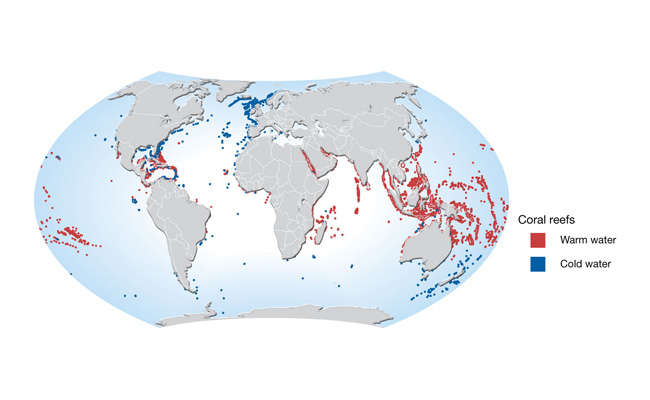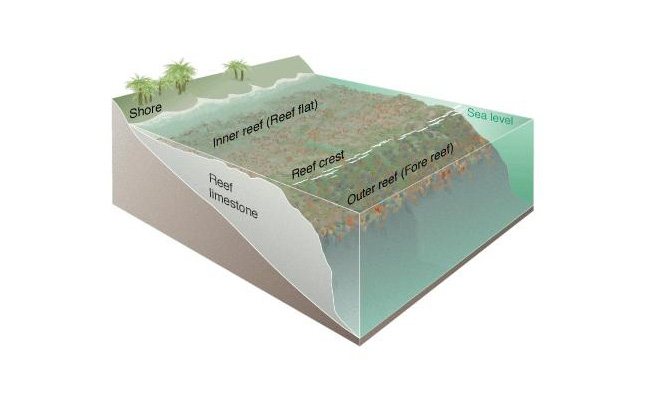« Prev Next »
What Is a Coral?
Corals are colonial organisms made up of individual polyps, each 1–3 mm in diameter, that are connected to one another via a thin layer of tissue (Figure 2). The connection between polyps allows for the sharing of nutrients. Beneath the soft bodies of scleractinian, or stony corals, polyps secrete a calcium carbonate skeleton, and it is this skeleton that becomes the foundation of coral reef ecosystems. Coral colonies can be either dieocious or hermaphroditic and can also reproduce asexually through fragmentation and reattachment. While reproductive strategies vary with the diversity of coral species, synchronous spawning events can cloud the water column with gametes and larvae (Figure 3).
While all scleractinian corals deposit calcium carbonate skeletons, not all stony corals grow large enough to build reef structures. In the tropics, hermatypic, or reef building corals, are able to grow and secrete their calcium carbonate skeleton with the aid of zooxanthellae, a group of single-celled dinoflagellates that live in the tissue of corals (Figure 4). Zooxanthellae are plantlike organisms that photosynthesize and exchange food and nutrients with their host coral. In the warm oligotrophic waters where corals thrive, the nutrition provided by zooxanthellae supplies the needed energy for corals to secrete layers of calcium carbonate. Even with the nutrition provided by zooxanthallae, the process of building a reef is slow. Branching species grow 10–20 mm per year while massive species grow 1 mm per year or less.
Abiotic Factors and Coral Reefs
The reliance of hermatypic (e.g., reef-building) corals on photosynthetic zooxanthallae to grow fast enough to produce reefs further limits coral reef distribution. Photosynthesis requires light, and the dependence of corals on zooxanthallae limits corals to shallow depths. Most reef building corals occur in less than 25 m of seawater. In addition, turbidity reduces light penetration, which restricts coral growth. High sedimentation rates can also bury or smother these sessile animals.
While corals gain some nutrition from their symbiotic zooxanthallae, corals are heterotrophic because they capture zooplankton from the water column with their tentacles. As a sessile organism, corals must rely on currents to bring food as well as aid in gas exchange; however, high flow can reduce the ability of corals to capture food and waves can fracture and damage corals.
Zooxanthallae give corals their pigment, such that the loss of the zooxanthallae, either through death, exiting the host coral, or actually being consumed by the coral itself, is commonly referred to as "bleaching" due to the remaining visible white coral skeleton. Corals live at the uppermost boundary of their temperature tolerance. Even a 1ºC increase in sea surface temperature can stress zooxanthallae, causing corals to bleach (Glynn 1993). While bleaching can be fatal to corals, especially when bleaching occurs over a large portion of the coral colony, corals are able to recover, obtaining new zooxanthallae from the water column.
In addition to the effects of temperature on reef health, increasing carbon dioxide concentrations in the atmosphere and subsequently the ocean lowers the pH — a process referred to as ocean acidification. While the net impact of lower pH on coral reefs continues to be examined, decreases in pH can reduce the calcification rates of corals and other calcifying organisms (Ries et al. 2009).
Formation and Zonation of Coral Reefs
Coral reefs can be separated into three distinct zones: the back reef, reef crest, and fore-reef (Figure 7). The back reef includes the shallow lagoon between the shore and coral reef. This habitat includes small patches of corals, sea grass beds, and sand plains. The back reef is often warmer because of the shallow depth, reduced water flow, and protection from waves. Salinity can also fluctuate due to fresh water inputs. In addition, sediment and runoff from shore can increase turbidity in this zone.
The reef crest is the pinnacle of the reef and can be exposed to the air during extreme low tides. The reef crest is a harsh environment, with the potential for desiccation and UV stress associated with a shallow environment. In addition, breaking waves limit coral diversity to only a few species that can persist in this high-energy zone. The staghorn coral, Acropora cervicornis, can form dense monotypic stands along the reef crest. The thin branches of A. cervicornis aid the coral in asexual reproduction, with branches breaking off and moving during large storm events. These forked or branched fragments can then become wedged into other coral rubble and reattach to the reef substrate (Tunnicliffe 1981).
The ocean side of the reef begins the fore-reef, which continues down in depth to a sand plain. Abiotic factors on the fore-reef are less stressful compared to other zones and ideal for coral growth. The highest diversity of corals is found in the fore-reef due to light accessibility. Coral diversity is greatest around 15–20 m depth and dramatically decreases with increasing depth and the resulting lower light availability. In addition, internal waves carry nutrients from deeper water to the fore-reef, providing additional food resources for coral reef communities.
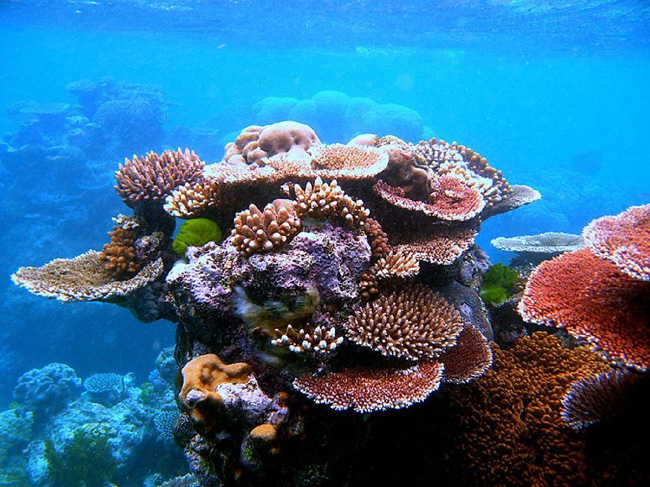
Diversity
Hermatypic corals are the foundation that supports at least a million species associated with coral reefs (Figure 8). Almost every phylum of living creature can be found living on coral reefs, with over 800 species of corals alone (Vernon 1995). Corals provide the substrate for sessile organisms to attach, including algae, sponges, and non-reef building corals (e.g., fire corals, soft corals, gorgonians). In addition to corals, encrusting bryozoans, sponges, and calcareous red algae act as biological-cement, keeping the reef framework intact (Figure 9). The diverse benthic flora and fauna along with the calcium carbonate understructure increases habitat heterogeneity, which provides a refuge from predation for invertebrates such as crabs, lobsters, sea urchins, brittlestars, and molluscs. The diversity of pelagic species is equally vast. In the waters above coral reefs, one can find nearly 25% of all marine fishes. Coral reefs, therefore, are one of the most diverse ecosystems on the planet, rivaling their terrestrial counterpart, tropical rain forests.

Given such enormous diversity and finite resources of space and food, interspecific interactions are a primary component structuring coral reef communities. Corals provide refuge to herbivorous fishes. Herbivorous fishes in turn graze on algae that can overgrow and outcompete slow growing corals. Trophic interactions have led to an endless array of predatory and defensive adaptations. Scorpion fish and frog fish have adapted camouflage to blend in with the surrounding reef (Figure 10). Sessile organisms, such as sponges, produce chemical compounds that deter predation (Pawlik et al. 1995).

Space is an extremely limiting resource on coral reefs. On steep slopes, plate-shaped corals grow out into the water column and shade underlying corals. Competition for both space and food also leads many filter-feeding organisms to grow away from the substrate and into the water column. And while corals provide the physical structure of reefs, faster growing organisms like algae and even sponges can overgrow slow growing corals. Corals must also compete for space with other coral species or even the same species. Corals use long sweeper tentacles that contain a high density of nematocysts for fending off encroaching individuals (Figure 11).
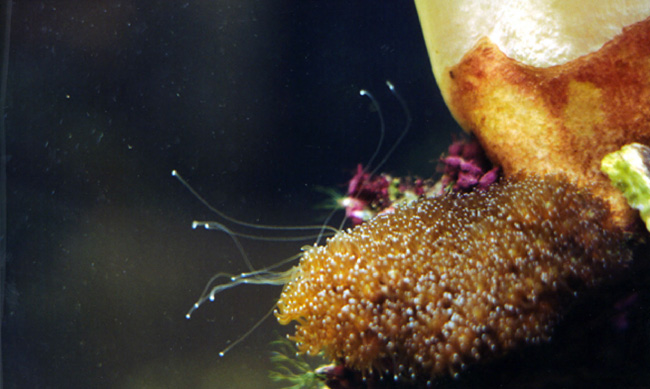
Facilitative interactions are also a hallmark of coral reef ecosystems. Juvenile wrasses, blennies, gobies, and shrimps live on large corals that are frequented by large fishes that are often covered with ectoparasites. The smaller "cleaner" organism consumes the parasite off the larger fish, both apparently benefiting from the association. Anemone fish in the Indo-Pacific are another example of mutualism on coral reefs. The anemone fish lives among the stinging tentacles of the sea anemone and gains a refuge from predation while the anemone gains nutrients from the fish's waste (Figure 12) While these interactions appear straightforward, scientists continue to work to understand the intricacies and nature of facilitative interactions in coral reef communities (e.g., Cheney & Cote 2005).

References and Recommended Reading
Cheney, K. & Cote, I. Mutualism or parasitism? The variable outcome of cleaning symbioses. Biology Letters 1, 162–165 (2005).
Glynn, P. W. Coral reef bleaching: ecological perspectives. Coral Reefs 12, 1–17 (1993).
Lalli C. & Parsons T. Biological Oceanography: An Introduction, 2nd ed. Oxford, UK: Butterworth-Heinemann Ltd. (1997): 213–222.
Pawlik, J. R. et al. Defenses of Caribbean sponges against predatory reef fish: I. Chemical deterrency. Marine Ecology Progress Series 127, 183–194 (1995).
Ries, J. B. et al. Marine calcifiers exhibit mixed responses to CO2-induced ocean acidification. Geology 37, 1131–1134 (2009).
Tunnicliffe, V. Breakage and propagation of the stony coral Acropora cervicornis. PNAS 78, 2427–2431 (1981).
Vernon, J. Corals in Space and Time — The Biogeography and Evolution of the Scleractinia. Sydney, Australia: University of New South Wales Press, 1995.




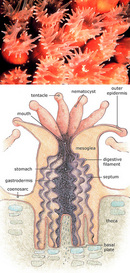
 Figure 2
Figure 2


